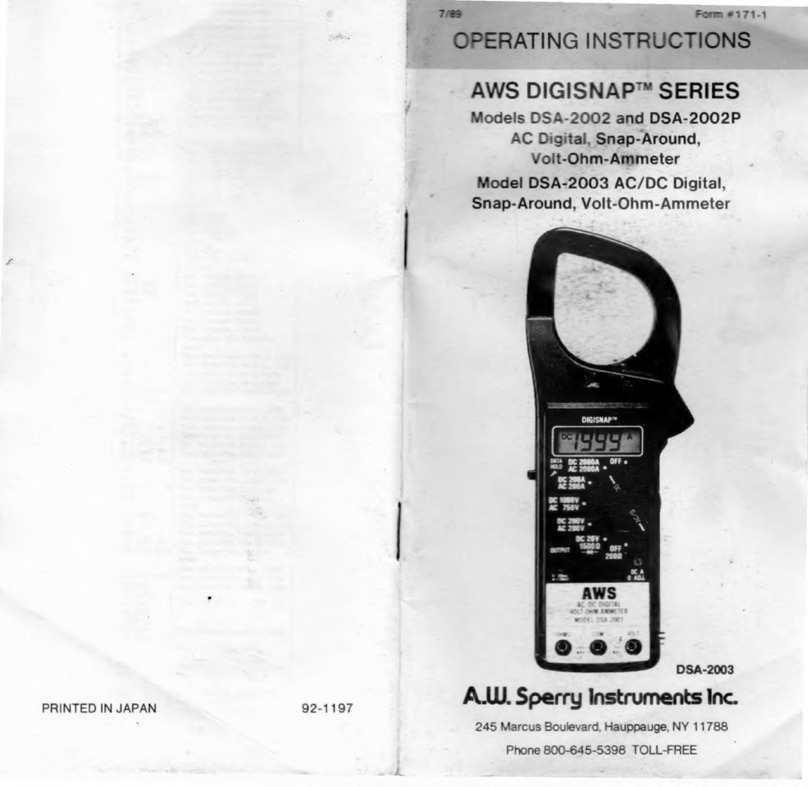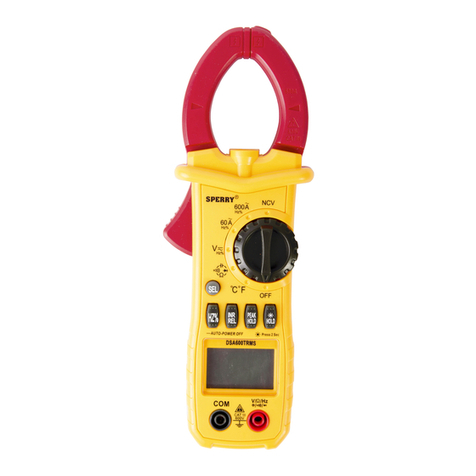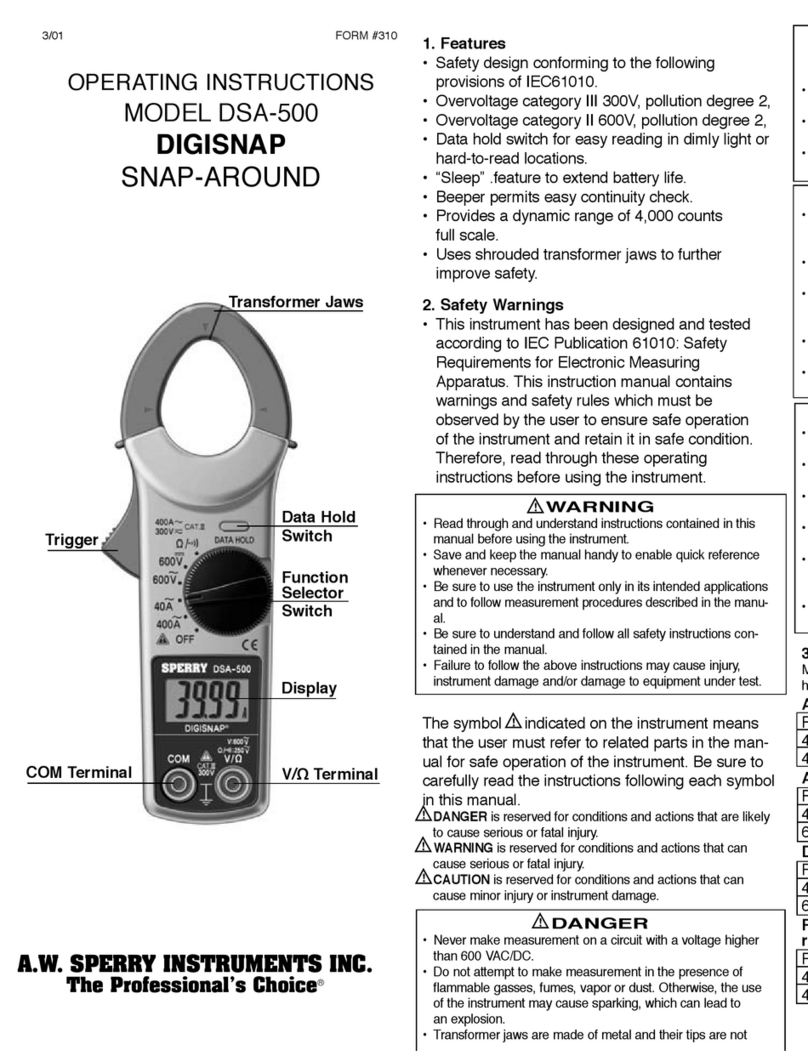
exposed conductive parts, however, extra pre-
caution should be taken to minimize the possibility
of shorting.
Do not make measurement with the Battery Cover
removed.
Disconnect the test leads from the instrument for
current measurement.
(1) Set the Function Switch to “600A” or “1000A” position.
(on DSA680, only “600A” is available) AC has been
selected by default; press the SELECT key, when DC
has been selected, to change it to AC. AC mark is
displayed at the upper left on the display.
(2) Press the trigger to open the transformer jaws and
clamp them onto the one conductor under test, then
take the reading on the display. Pressing the
“ Hz/DUTY” Key switches the indication in following
sequence.
ACCurrent Hz DUTY
Hz/DUTY Function requires 50A or more at AC600A
Range and 350A or more at AC1000A range.
CAUTION
Max conductor size for DSA680 is approx dia.
33mm and for DSA1020 is approx dia. 40mm.
During current measurement, keep the trans-
former jaws fully closed. Other wise, accurate
measurements cannot be taken.
5-2. DC Current Measurement
DANGER
Never make measurement on a circuit in which
voltage over DC600V exists to avoid getting
electrical shock.
Do not make measurement with the Battery Cover
removed.
(1) Set the Function Switch to “600A” or “1000A” position.
AC has been selected by default; press the SELECT
key, when AC has been selected, to change it to DC.
(only 600A is available on DSA680)
DC mark is displayed at the upper left on the display.
(2) With the transformer jaws closed and without
clamping them onto the conductor, press the “ZERO”key
to zero adjust the display. (mark is displayed at the
upper right on the display.)
(3) Press the trigger to open the transformer jaws and
clamp them onto the one conductor under test, the
conductor should be at the center of the jaws, then take
the reading on the display.
(4) Set the Function Switch to an appropriate position
according to current under test.
(5) Pressing the “ZERO” key again releases “ZERO”
function. (mark at the upper right on the display
disappears.)
5-3. AC Voltage Measurement
DANGER
Never make measurement on a circuit in which
voltage over AC600V exists to avoid getting
electrical shock.
Do not make measurement with the Battery Cover
removed.
Keep your fingers behind the barrier on the
instrument during measurement.
(1) Set the Function Switch to “ACV” position.
(2) Connect the red test lead to V/terminal and the
black test lead to COM terminal.
(3) Connect the test leads to the circuit under test. Take
the reading on the display. Pressing the “Hz/DUTY” key
while reading is indicated on the display switches the
indication in following sequence.
ACVoltage Hz DUTY
CAUTION
Hz/DUTY Function requires AC40V or higher.
To measure a frequency, measure the voltage on
the electrical circuit in advance. Then press the Hz
/DUTY key to enter into frequency measurement.
Readings of frequency may fluctuate or be
influenced under noisy environment.
5-4. DC Voltage Measurement
DANGER
Never make measurement on a circuit in which
voltage over DC600V exists to avoid getting
electrical shock.
Do not make measurement with the Battery Cover
removed.
Keep your fingers behind the barrier on the
instrument during measurement.
(1) Set the Function Switch to “DCV” position.
(2) Connect the red test lead to V/terminal and the
black test lead to COM terminal.
(3) Connect the red and black test leads to the positive
(+)and negative (-) sides of the circuit under test
respectively. Take the reading on the display. If the
connection is reversed, the display indicates the “-“ mark.
5-5. Resistance/ Diode/ Cont/ Capacity
Measurement
DANGER
Never use the instrument on an energized circuit.
Do not make measurement with the Battery Cover
removed.
Resistance
(1) Set the Function Switch to “Ω/Diode/Cont/Capacity”
position.
(2) Connect the red test lead to V/terminal and the
black test lead to COM terminal. Confirm “OL” is
indicated on the display, and then short-circuit the tips of
test leads to make the indication zero.
(3) Connect the test leads to the both ends of the resistor
under test.
(4) Take the reading on the display.
CAUTION
Even if short the test lead tips, indicated value may
not be zero. But this is because of the resistance of
test leads and not a failure.
When test leads are open, “OL” is indicated on the
display.
Continuity
(1) Set the Function Switch to “Ω/Diode/Cont/Capacity”
position. “Ω“ has been selected by default; press the
SELECT key to change it to “Continuity”
Resistance Diode Cont Capacity
(2) Connect the red test lead to V/terminal and the
black test lead to COM terminal. Confirm “OL” is
indicated on the display and short-circuit the tips of test
leads.
Indication should become zero and buzzer sounds.
(3)Connect the test leads to the both ends of the
conductor under test. The buzzer sounds, if the
resistance under test is 100or less.
Diode
(1)Set the Function Switch to “Ω/Diode/Cont/Capacity”
position. “Ω“ has been selected by default; press the
SELECT key to change it to “Diode”
Resistance Diode Cont Capacity
(2) Connect the red test lead to V/terminal and the
black test lead to COM terminal.
(3)Connect the red and black test leads to the Anode and
cathode of the diode under test respectively.
Take the reading on the display. If the connection is
reversed, the display indicates “OL”.
CAUTION
Some of diodes cannot be tested. Indication on
the display will be “OL”.
(Zener diode, LED and so on)
Capacity
(1)Set the Function Switch to “Ω/Diode/Cont/Capacity”
position. ““ has been selected by default; press the
SELECT key to change it to “Capacity”
Resistance Diode Cont Capacity
(2) Connect the red test lead to V/terminal and the
black test lead to COM terminal.
(3)Connect the test leads to the both ends of the
capacitor under test.
(4) Take the reading on the display.
5-6 Temperature Measurement
(1) Set the Function Switch to “ºC/ºF” position.
(2) Connect the K-type Temperature Probe to the
input terminal. Positive (+) side of Probe should be
connected to V/.
(3) Contact the Sensor (metal part) of K-type
Temperature Probe to the object under test. Take the
reading on the display.
Positive (+) side of Probe should be connected to V/.
WARNING
Never connect the Temperature Probe to an
energized circuit.
CAUTION
Room temperature is indicated on the LCD when
setting the Function Switch to “ºC/ºF” position. In
case that “OL” or anything other than room
temperature is indicated, something may wrong
with the instrument. Stop the use of instrument
immediately.
There may be a break in Probe when indication
isn’t changed if Sensor (metal part) of K-type
Temperature Probe is contacted with the object
under test.
6. Other functions
6-1. Sleep Function
(1) This is a function to prevent the instrument from being
left powered on in order to conserve battery life. This
function causes the instrument to enter Sleep mode
about 15 minutes after the last key operation. To exit the
Sleep mode, turn the Function switch to “OFF”, then to
any other position.
(2) Sleep Function is disabled when;
MIN/MAX or PEAK Function is selected. Continuous
measurement is made with the Sleep Function being
disabled. To activate Sleep Function again, disable the
MIN/MAX or PEAK Function.
CAUTION
The instrument consumes small amount of battery
power in the Sleep mode. Set the Function Switch
to the OFF position after use.
6-2. HOLD Key
(1) Data Hold Function
This is a function to freeze the measured value on the
display. Press the “HOLD” key to freeze the reading.
The reading will be held regardless of subsequent
variation in input. “H” is indicated on the upper left corner
of the display while the instrument is in the Data Hold
mode. To exit Data Hold mode, press the “HOLD” key
again.
node
Cathode
CAUTION
Held readings are released when Sleep Function
is activated while the instrument is in the Data Hold
mode.
(2) Backlight ON/OFF
Pressing the HOLD key 2 sec or more lights up the
Backlight. Pressing the HOLD key 2 sec or more again
turns off the Backlight.
6-3. NCV Function
Red LED on the upper area on the Panel lights up
at all ranges except for OFF when electric field
exceeding 100V is detected by the sensor installed in
the Jaws. It indicates a presence of voltage in an
electrical circuit or equipment without
touching them.NCV Sensor
can detect electrical field
only from the direction
indicated in the right
figure.Put the fixed
element (left side)
closer to the conductor
under test. Detection against
in-wall outlet is impossible.
DANGER
The LED may not light up due to installation
condition of electrical circuit or equipment. Never
touch the circuit under test to avoid possible
danger even if the LED for NCV doesn’t light up.
Check the functionality of LED on a well-known
power supply prior to measurement. When the
LED doesn’t light up, do not make measurement.
NCV indication is affected by external voltage, how
to hold or place the instrument.
6-4. MIN/MAX Function
CAUTION
SELECT, ZERO, Hz/DUTY keys are disabled
while MIN/MAX Function is being activated.
(1) AC/DC Current Range (600A only on DSA680)
Pressing the MIN/MAX Key at 600A & 1000A Function
enables min or max value measurement. Press the
MIN/MAX Key to select MAX or MIN. The max or min
value within measuring range is being held until this
function is disabled. “MIN” or “MAX” is indicated on the
display while this function is being activated. To disable
this function, press down the MIN/MAX Key at least 2
sec or change functions.
(2) AC/DC Voltage Range
CAUTION
Pressing the MIN/MAX Key without applying voltage
disables the Auto-ranging function and fixes the
Range to 6V. Connect the test leads to the circuit
under test and press the MIN/MAX Key after an
appropriate range is selected by Auto-ranging
function.
Pressing the MIN/MAX Key enables min or max value
measurement. Press the MIN/MAX Key to select MAX
or MIN. The max or min value within measuring range is
being held until this function is disabled. “MIN” or “MAX”
is indicated on the display while this function is being
activated.
To disable this function, press down the MIN/MAX Key
at least 2 sec or change functions.
6-5. ZERO Function
CAUTION
MIN/MAX, PEAK keys are disabled while ZERO
Function is being activated.
Zero Adjustment Function at Current Range “∆” mark is
to be indicated at the upper right on the display while
ZERO function is being operated.
Indication of relative value at Current, Voltage,
Resistance:
Pressing the ZERO Key indicates REL (relative value)
Press the ZERO Key to save the initial value at the start
of measurement as a reference value. Then the
difference between the later measured values and the
reference value is indicated on the display. The
Auto-ranging function is disabled, while this function is
being activated, and the Range is fixed to the Range
selected at the start of measurement. Relative value is
indicated within following ranges.
(Measuring range) =
(Full-scale value at the fixed Range) – (initial value)
To disable this function, press down the MIN/MAX Key
at least 2 sec or change functions.
6-6. PEAK Function (600A only on DSA680)
(1) Set the Function Switch to “AC Current” Range and
clamp onto a conductor under test.
(2) Pressing the PEAK Key indicates “PMAX” on the
display and initiates measurement.
(3) Readings indicates the PEAK of current crest value.
When measuring sine wave, reading is about 2
timesof RMS value.
(4) Press the PEAK Key at least 2 sec to reset the
indication or release PEAK Function.
Buzzer sounds twice, and the Function is released.
CAUTION
PEAK indication for Crest value is up to 1500A.
Error indication is given when exceeding this
range value.
Sleep Function is disabled when PEAK Function
is selected. Care should be taken when
performing continuous measurement.
6-7. Over-flow indication
When the input exceeds the measuring range at each
Function other than Voltage ,1000A and Temperature
Range "OL" or "-OL" is indicated on the display.
7. Battery Replacement
WARNING
To avoid electrical hazard, set the Function Switch
to “OFF” and remove the test leads from the
instrument before trying to replace batteries.
CAUTION
Do not mix old and new batteries.
Install batteries in correct polarity as indicated in the
Battery Compartment.
Replace the batteries when a Low Battery Voltage warning
“BATT” mark is indicated on the display. Note that when the
battery is completely exhausted, the display blanks without
“BATT” mark shown.
(1) Set the Function Switch to “OFF” position.
(2) Unscrew and remove the Battery Compartment cover
on the bottom of the instrument.
(3) Replace the batteries observing correct polarity. Use
new R03 (AAA) or LR03 / 1.5V batteries.
(4) Install the Battery Compartment and tighten the screws.
8. Maintenance
Cleaning
Use a cloth dipped in water or neutral detergent for
cleaning the instrument.
Do not use abrasives or solvents. Otherwise, instrument
get damaged, deformed or discolored.
Lifetime Limited Warranty
The attention to detail of this fine snap-around
instrument is further enhanced by the application of A.W.
Sperry's unmatched service and concern for detail and
reliability.
These A.W. Sperry snap-arounds are internationally
accepted by craftsmen and servicemen for their
unmatched performance.
All A.W. Sperry's snap-around instruments are
unconditionally warranted against defects in material
and workmanship under normal conditions of use and
service; our obligation under this warranty being limited
to repairing or replacing free of charge, at A.W. Sperry
snap-around instrument that malfunctions under normal
operating conditions at rated use.*1
Replacement procedure
Securely wrap the instrument and its accessories in a
box or mailing bag and ship prepaid to the address
below.
Be sure to include your name and address, as well the
name of the distributor, with a copy of your invoice from
whom the unit was purchased, clearly identifying the
model number and date of purchase.
A.W.SPERRY INSTRUMENTS INC.
ATT: Customer service dept.
2150 Joshua's Path, Suit 302,
Hauppauge, N.Y. 11788
*1 .The warranty is not applicable if the instrument
has been: misused, abused, subjected to loads in
excess of specifications, has had unauthorized
repair or has been improperly assembled or used.
*Note: Recommended calibration interval should not
exceed one year. Calibration service charges are not
covered terms and conditions of warranty.
05-11 92-1806






















